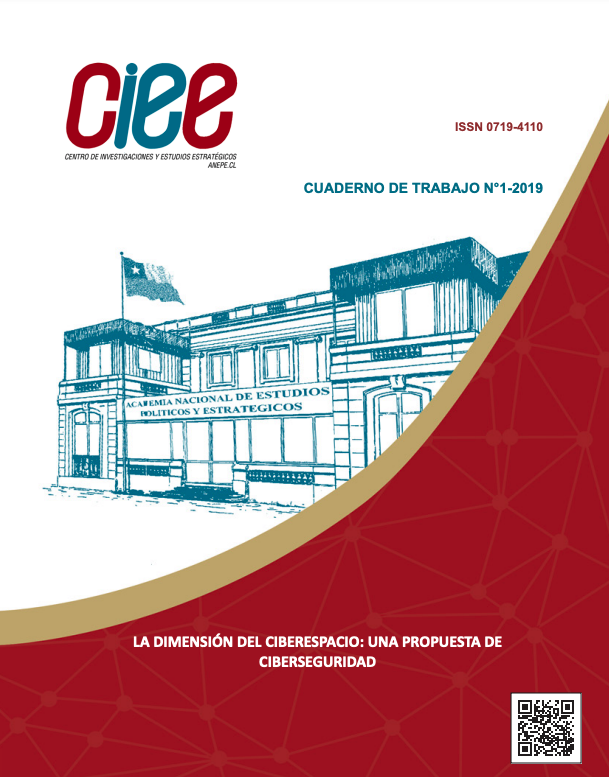LA DIMENSIÓN DEL CIBERESPACIO: UNA PROPUESTA DE CIBERSEGURIDAD
Contenido principal del artículo
Resumen
El ciberespacio ha cambiado tanto paradigmas tradicionales como modernos, desde las relaciones sociales y los negocios hasta los dominios de guerra. Las últimas décadas han evidenciado el potencial del entorno digital como una herramienta real para los menesteres militares, yendo mucho más allá de los roles meramente colaborativos que antiguamente se le asignaban. Una defensa moderna requiere de una capacidad no solo técnica y tecnológica para abordar este espacio virtual y sus desafíos, sino también de una capacidad organizacional y administrativa que pueda ser transmitida claramente en los roles que cada unidad debe realizar en función del ciberespacio. Con esta realidad en mente, se presenta una propuesta de definiciones y estructuras de esta dimensión basada en funciones, con el objetivo de que puedan ser implementadas de forma eficiente y armónica en entidades tanto públicas como privadas.
Detalles del artículo
Descargas

Esta obra está bajo licencia internacional Creative Commons Reconocimiento-SinObrasDerivadas 4.0.
Los autores mantienen en todo momento los derechos sobre sus respectivos artículos, por otra parte, la Revista Cuaderno de Trabajo está distribuida bajo una Licencia Creative Commons Atribución 4.0 Internacional.
Citas
personalpages.manchester.ac.uk/staff/m.dodge/cybergeography/about.html
ALEXANDER, Keith B. Warfighting in cyberspace. national defense univ washington dc inst for
national strategic studies, 2007.
ANABALÓN, Juan y DONDERS, Eric. Una revisión de ciberdefensa de infraestructura crítica. ESD,
2014, p. 131.
CANO, Jeimy. Ciberseguridad y ciberdefensa: dos tendencias emergentes en un contexto global.
Sistemas (asociación colombiana de ingenieros de sistemas)(0119), 4-7. 2011
CJCS, JOINT CHIEFS OF STAFF, 2018, JP 3-12. “Cyberspace Operations”. Federation of American
Scientists, Intelligence Resource Program, Department of Defense of the United States of America.
Computer Forensics, 2008. [En línea] [último acceso: 29/10/2018] Disponible en: https://www.uscert.gov/sites/default/files/publications/forensics.pdf
DEL RÍO Durán, Juan Díaz. La ciberseguridad en el ámbito militar. Cuadernos de estrategia, 2011,
N° 149. pp. 215-256.
DENNING, Peter J. y DENNING, Dorothy E. Discussing cyber attack. Communications of the ACM,
2010, vol. 53, no 9, pp. 29-31.
DÍAZ del río, J. “Ciberseguridad. Retos y amenazas a la seguridad nacional en el ciberespacio”
Capítulo V: “La ciberseguridad en el ámbito militar.”, ISSN 1697-6924, Nº. 149, 2011.
EI-ISAC™ Cybersecurity Spotlight – CIA Triad. CIS Control 20: Penetration Tests and Red Team
Exercises [online]. [Accessed 13 november 2018]. Available from: https://www.cisecurity.org/spotlight/
ei-isac-cybersecurity-spotlight-cia-triad/
FARWELL, James P. y ROHOZINSKI, Rafal. Stuxnet and the future of cyber war. Survival, 2011, vol.
53, N° 1, pp. 23-40.
GOEL, Sanjay. Cyberwarfare: connecting the dots in cyber intelligence. Communications of the ACM,
2011, vol. 54, N° 8, pp. 132-140.
HOLMNER, Marlene Amanda, “et al”. A critical analysis of information and knowledge societies with
specific reference to the interaction between local and global knowledge systems. 2008. Tesis
Doctoral. University of Pretoria.
JOYANES, A. “Big Data Análisis de grandes volúmenes de datos en organizaciones”, 1era. Edición,
México, AlfaOmega, ISBN-10: 8426720811, 2013.
JUSTRIBÓ, Candela. Ciberdefensa: una visión desde la UNASUR. En: VII
Congreso del IRI/I Congreso del CoFEI/II Congreso de la FLAEI (La Plata, 2014). 2014.
KLIMBURG, Alexander (ed.) National cybersecurity framework manual. NATO
Cooperative Cyber Defense Center of Excellence, 2012.
KUEHL, Daniel T. From cyberspace to cyberpower: Defining the problem. Cyberpower and national
security, 2009, vol. 30.
LEÓN, José Domínguez. La ciberguerra como realidad posible contemplada desde la prospectiva.
Revista de Pensamiento Estratégico y Seguridad CISDE, 2016, vol. 1, no 1, pp.18-32.
LEWIS, James A. Computer Espionage, Titan Rain and China. Center for Strategic and International
Studies-Technology and Public Policy Program, 2005, vol. 1.
LIBICKI, Martin C. Cyberspace is not a warfighting domain. ISJLP, 2012, vol. 8, p. 321.
LÓPEZ, J. D. “III jornadas de ciberdefensa del mando conjunto de ciberdefensa.” [En línea] [Último
acceso: 29/10/2018] Disponible en: https://jornadasciberdefensa.es/
MAHMOOD, Tariq y AFZAL, Uzma. Security analytics: Big data analytics for cybersecurity: A review of
trends, techniques and tools. En Information assurance (ncia), 2013 2nd national conference on. IEEE,
2013. pp. 129-134.
MORUECO, MIGUEL. El ciberespacio como nuevo espacio político: notas para una ontología política
nómada. [online]. UAM. [Accessed 29 october 2018]. Available from: http://www.uibcongres.org/
imgdb/archivo_dpo1785.pdf
OWASP, Top. TOP 10–2017: The ten most critical web application security risks. The Open Web
Application Security Project, 2017.
RUUS, Kertu. Cyber war I: Estonia attacked from Russia. European Affairs, 2008, vol. 9, no 1-2.
TAGUE, N , The Quality Toolbox. Second Edition, ASQ Quality Press, 2004. pp. 390-392.
TANKARD, Colin. Advanced persistent threats and how to monitor and deter them. Network security,
2011, vol. 2011, N° 8. pp. 16-19.
TASCÓN, M. y COULLAUT, A. (2016) “Big Data y el internet de las cosas”, Catarata, ISBN:9788490970744,
2016
THORNBURGH, Nathan. Inside the Chinese Hack Attack. Times, august, 2005, vol. 25.
WAXMAN, Matthew C. Cyber-attacks and the use of force: Back to the future of article 2 (4). Yale J.
Int’l L., 2011, vol. 36, p. 421.
WERKHÄUSER, Nina. German Army Launches New Cyber Command. Deutsche Welle, april, 2017,
vol. 1.
WHITE, SARAH, 2018, Understanding Cyberwarfare: Lessons from the Russia-Georgia War. Modern
War Institute (MWI) at West Point.
